— June 2, 2019
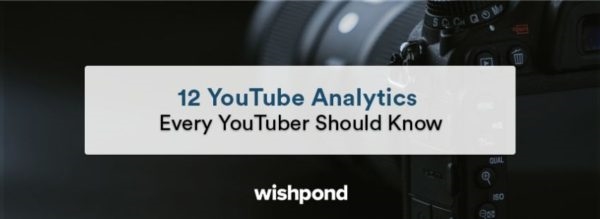
Having a YouTube channel is a great way to put your content in front of over a million viewers. Plus, YouTube videos tend to have a longer shelf life when compared to content on other platforms.
But once your video content is uploaded, you’ll still need to keep your eye on a few key metrics to put your YouTube channel on the path to success.
Some YouTubers tend to stay away from their Youtube Analytics because it can feel overwhelming at first, but avoiding it won’t help you to understand it.
So, In this article I’ll be showing 12 Youtube Analytics every youtuber needs to know.
1. YouTube Analytics to Track: Watch Time
Your Watch Time report shows you the number of minutes your viewers spend watching your videos.
The longer your viewers watch your videos the more Youtube will recommend and push your video on the search page. YouTube’s algorithm values videos with longer watch times because it means people are spending more time on YouTube.

You can use this report to see the total watch time you’ve accumulated since starting your YouTube channel.
5 Tips To Increase Your YouTube Watch Time
The only way to increase your watch time is to keep viewers watching for longer. So how do you keep those eyes glued to the screen?
Here are five ways to increase your watch time:
- Capture a viewer’s attention in the first 5-10 seconds of your YouTube video. Your intro has to rope them in right away, or they’ll go to another video to find what they want.
- Take a look at your Audience Retention scores to help you learn how many viewers end up watching to the very end of your videos.
- Contrary to popular belief, making a longer video can help to increase your watch time because longer videos tend to do better naturally. But it’s all about balance, it can’t be too short, or you’ll have to make more videos to fight for more watch time, and it can’t be too long so that when people see the video’s time length, they avoid watching it.
- Create content that’s worth watching for your viewers. You can’t fill your video time with fluff, no matter what length your video is. Fill it with content people want to watch they’ll sit through the entire video no matter how long it is.
- Add an intro an amazing into the clip to your YouTube video. Try being direct about what your video is about or by adding a little cliffhanger to keep them interested. It’ll only add a few seconds or up to a minute, but it’s watch time that can add up over time. Trust me it adds up in the end.
2. YouTube Analytics to Track: Impressions Click-Through Rate
Your Impressions click-through rate report, holds a bit more weight than your typical impression report.
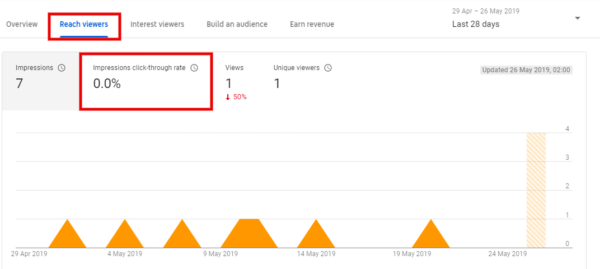
Your impression click-through rate is more important because it shows how often viewers interact with your video after seeing it as it tries to show your video to the audience most likely to watch it.
YouTube starts surfacing your video to a relevant audience. Based on hundreds of signals, our systems determine which viewers are most likely to watch your video.
Your impressions click-through rate usually spikes as soon as you release a new video because your subscribers will be alerted or shown your new content first, then YouTube’s algorithm will do the rest. From there, your click-through rate will decline and then stay at a stable rate.
Pro Tip: Learn Who Watches Your Video
Sometimes this report can feel a bit dismal, but pair it with your average percentage viewed and average view duration and you can start to get an idea of how many people watch your video from start to finish.
Yes, a high click-through rate may be good but if people click on your video and leave after the first 5 seconds, you’re losing out on potential subscribers.
3. YouTube Analytics to Track: Average View Duration
Your average view duration is the total watch time of your video divided by the total number of video plays, including video replays.

This report helps you to see how well your video engages with viewers. The less engagement your video has with your audience, the more your average view duration and watch time will drop. Average view duration also affects your recommended ranking and video search.
Think of your average view time just as an Instagram post, the more likes, and engagement you get, the more Instagram will show your content in people’s feeds.
For most videos, an average view duration in the 70-80% range is performing well. Anything above that is a very well constructed video.
Pro Tip: Youtubers frequently ask the question “How can I get more views on YouTube?” But what you should be asking is “Who am I creating videos for?”. Once you answer this question, you can create videos specifically that draw in the attention of your target audience. This automatically helps to increase your average watch time.
4. YouTube Analytics to Track: Audience Retention
Audience retention shows you the percentage of viewers who watch and leave your video at a certain point. You can use your audience retention report to help you with your future video strategy.
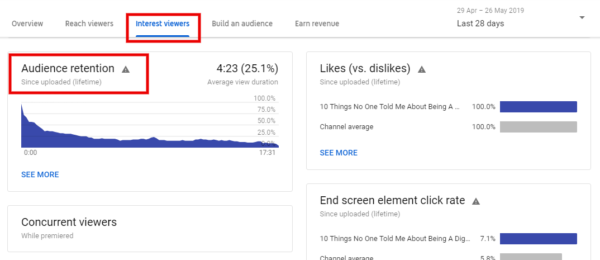
You can use the most engaging parts of your video to spark new video topic ideas and use the least engaging parts of your videos as cues to stop creating content around those topics moving forward.
YouTube rewards videos with high retention with high rankings in search and suggestions because it’s proven to grab viewers attention.
There are two types of retention reports you should pay attention to your absolute retention curve and relative retention curve.
The absolute retention curve report shows you which video and how well it retains viewers. I find that paying close attention to the first 15 seconds of your video can help you to see when viewers are most likely to drop-off.
The relative retention curve report compares how well your YouTube videos are performing with channels with similar audiences. Keep in mind that your audience retention curve report is based on worldwide data even if you select a specific location to see the data.
You can also view your retention traffic by organic or paid traffic.
5. YouTube Analytics to Track: Re-Watches
This report shows you the number of times viewers re-watch certain parts of your video. You see your re-watches in your retention report, re-watches are usually indicated by rising curves in the graph.
Having your videos watched over and over again is always a plus. If a lot of people are re-watching a particular video or a specific part of your video, it means that specific video topic is a popular one.
6. YouTube Analytics to Track: Engagement
Like any social media platform engagement helps to grow your channel. YouTube comments, shares, likes, and dislikes are quantifiable data points that allow marketers to see how their videos are really doing. If you create great videos but have little to no likes or comments, you might be missing something.

3 Easy Ways To Increase YouTube Engagement
- Try to encourage shares, likes, and comments on your videos. Don’t be shy to ask for what you want. At the beginning or end of your video encourage viewers to comment below or like your video. Viewers are more likely to give engagement when they know your open to it. Give it a try and see what happens.
- Take the time to converse with your audience: one mistake YouTubers often make after asking for engagement is not taking the time to foster engagement back with their viewers after they leave a comment or a like. Take the time to answer comments and even say thanks for all the likes on your last video in your next video. This lets your viewers see and feel that their engagement is meaningful to you. Be the friend or expert that they never knew they needed.
- Monitor your video engagement: videos with the most engagement will naturally rise to the top. Make a note of the topic, length, and posting schedule of videos to see how you can rework successful videos into other videos, or potentially change your strategy moving forward.
7. YouTube Analytics to Track: Real-Time Report
This report helps you to see the total views for all videos on your YouTube channel and gives you insights into your most recently published videos. This will come in handy to know if you need to boost your promotion strategy. You can also see this data in reports for individual videos.
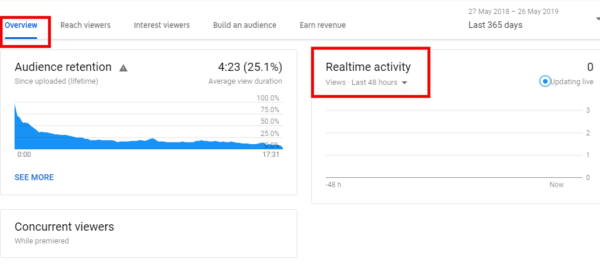
8. YouTube Analytics to Track: Card Click-Through-Rate
YouTube cards allow you to put clickable call-to-actions on your videos, prompting viewers to click.
Cards can appear at any point in your video, including, external links, and even content that’s downloadable for viewers to have — they’re definitely a plus for any beginner or expert Youtuber.
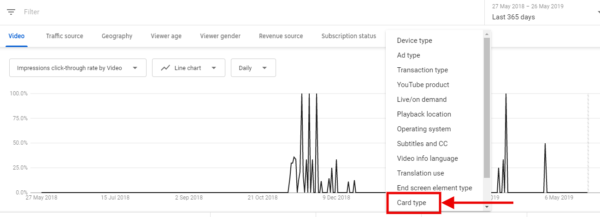
Each of your cards’ click-through rate or card reports shows you which call-to-action viewers prefer compared to others while watching your videos and can help you boost your watch time and grow subscribers.
It can be a bit tricky at first, but after a while, you’ll begin to understand the best places and timing to place your YouTube cards on future videos.
Analyzing card click-through rates can also help you uncover the optimal timing, placement, and the duration of your cards in future videos. You can find your cards’ click-through rates in the Cards Report.
9. YouTube Analytics to Track: Playlist Engagement
YouTube playlist helps to organize your videos on your channel in search. Viewers can watch as many videos at a time with the help of topic-specific playlist.
Having the right keywords gives your playlist more potential for ranking on Google and YouTube searches.
Your playlist engagement is seen under your YouTube Playlist Report. This report is measured by two main metrics: views per playlist start and average time in a playlist.
Views per playlist start are the average number of video views your playlists gather, and average time in the playlist is the average amount of time that viewers viewed the videos in your playlist.
Pro Tip: If your playlist metrics are low try editing and reorganizing your playlist with the videos with the highest retention report or average watch time.
10. YouTube Analytics to Track: Unique Viewers
Unique viewers help you to understand the actual size of your audience who have watched your videos over some time.
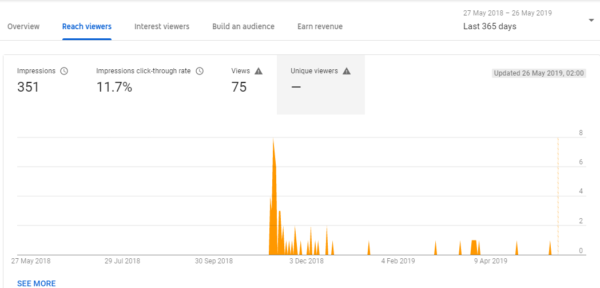
Unique viewing metrics are located under reach views and audience tab in your YouTube studio.
You can combine this metric along with engagement and retention reports if your views are low or not getting enough subscribers.
You might need to get a bit more active with your engagement or asking viewers to subscribe and turn on the notification bell.
11. YouTube Analytics to Track: Traffic Sources
Every YouTuber needs to know where their traffic is coming from, social media, external referrals like social media or internal referrals from their own website or platform.
This allows you to find the best platforms to promote your videos on. For example, if you see most of your traffic coming from your Instagram page, then incorporating your videos in your Instagram can drive more subscribers your way.
Your YouTube traffic source report shows you how your viewers find your video content and what source helps to grow your subscribers, views, and watch time.
While your YouTube traffic report gives a good overview of traffic sources, adding Google Analytics is always a great addition for more in depth insights. If you’re new to Google Analytics here’s a step-by-step guide on to Setup Google Analytics In under 15 minutes..
12. YouTube Analytics to Track: Subscriber Growth
Reviewing your subscriber growth helps you to measure your efforts to grow your YouTube channel. Your subscribers are your most loyal fans when to comes to your content and overall brand.
Without subscribers, you wouldn’t have anyone to frequently watch your videos, boost your views in search or recommendations, and gain more re-watch time and advocate for your YouTube channel (offline and online).
YouTube’s Subscribers Report shows you which videos, locations, and when you lose or gain subscribers.
If you’re worried about getting more subscribers here are 17 Ways to Get More YouTube Subscribers.
As important as subscribers are you shouldn’t let them be your main focus, or you’ll lose sight of the real prize. Most YouTubers end up getting burned out when they only focus on getting their numbers up.
The real goal of having a YouTube channel is for your brand to be seen as a go-to for any video content you create along with creating a community of loyal followers. Once you do that your subscribers will grow along with you.
Summary
Here are 12 YouTube analytics every marketer should know:
- Watch Time
- Impressions Click-Through Rate
- Average View Duration
- Audience Retention
- Re-Watches
- Engagement
- Real-Time Report
- Card Click-Through-Rate
- Playlist Engagement
- Unique Viewers
- Traffic Sources
- Subscriber Growth
Using YouTube analytics and reports is crucial to your channel’s success. Your analytics are tailored to your channel so that you can use them to see where there’s an opportunity to improve and see if your efforts are paying off.
Digital & Social Articles on Business 2 Community
(52)
Report Post







